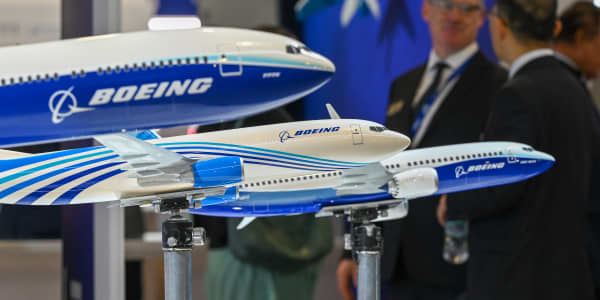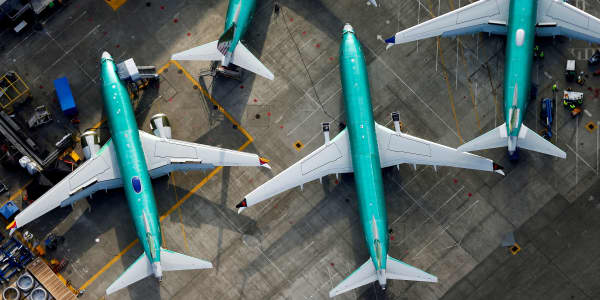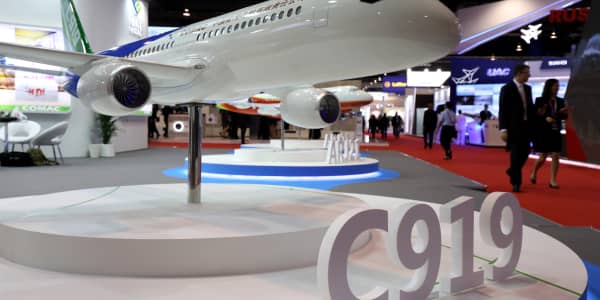Airlines did not sign any major deals to purchase new planes this week during the largest airshow in Asia — but aircraft manufacturers struck an optimistic tone.
The Singapore Airshow, which bills itself as "Asia's largest aerospace and defense event," continues through Sunday, but the event so far hasn't lived up to the usual role of hosting major deal announcements.
That is, the likes of Boeing and Airbus use airshows around the world to pen crucial agreements with airlines. But, as of Feb. 8, Singapore's show had only seen one commercial aircraft deal signed: Italian turboprop maker ATR said it agreed to sell four planes to Bangkok Airways.
Still, plane makers attending the annual event said they were confident that rising demand for air travel in Asia Pacific would keep their order books full for new planes in coming years.
With growing disposable income and more affordable plane fares, air travel is expected to nearly double globally in the next 20 years. The International Air Transport Association, a trade body representing airlines, predicted that in 2036, about 7.8 billion passengers would travel by air, compared to last year's expected 4 billion travelers. Most of that demand, according to IATA, would come from the Asia Pacific region.
To keep pace with that demand, airlines are likely to add new planes to their existing fleets and spend more on maintenance, repair and operations — a decision that would benefit plane makers like Boeing and Airbus.
"If you look at all the future orders, around 40 percent of the new aircraft orders are coming from airlines in Asia," Andrew Herdman, director general of the Association of Asia Pacific Airlines, told CNBC. "Airbus and Boeing have understood this clearly."

Indeed, Eric Schulz, chief of sales, marketing and contracts at Airbus, told a news conference this week that Asia Pacific has become a tremendously important region for the plane maker. He pointed to the firm's 20-year forecast released last year that predicted the region to account for 41 percent of new deliveries between 2017 and 2036.
"The demand for Asia Pacific, we think that it's around 10,000 single-aisle aircraft, which basically will equal for 40 percent of the world demand," he said. "We expect about 4,000 twin-aisle airplanes (in Asia Pacific), which equals to 46 percent of the market and of the large and very large airplanes, we expect about 650, which is again around 46 percent of the market."
Meanwhile, Randy Tinseth, vice president of marketing at Boeing Commercial Airplanes, told CNBC on Monday that Asia Pacific was Boeing's biggest market for single-aisle planes, wide bodies and freighters. He added that it was all about building the right types of airplanes for the various airlines. In Boeing's market outlook, the plane maker predicted Asia Pacific to account for 37 percent, or 17,520 aircraft, of the world fleet by 2036.
Smaller plane makers like Embraer also see the region as a key driver for growth in the next two decades. "When we think about the Indian subcontinent through to China, that's going to account for roughly 29 percent of the growth in the up-to-150-seats segment over the course of the next 20 years," John Slattery, president and CEO at Embraer Commercial Aviation, told CNBC.

Still, there are some challenges ahead, according to industry players. For example, rising fuel prices could affect the profitability of airlines and result in higher fares that could, in turn, affect demand. Moreover, the industry would need to keep up with infrastructure to support the growing demand that is expected over the next two decades — especially in Asia Pacific.
"Infrastructure is critically important," Herdman told CNBC. "By that, I mean airports, runways, terminal capacity and, less visible, but, airspace management capacity in the air." He explained that since the industry is growing faster in Asia than elsewhere, there is growing pressure to add infrastructure in large amounts in markets like China, India, Philippines and even existing aviation hubs like Singapore.





